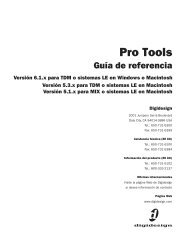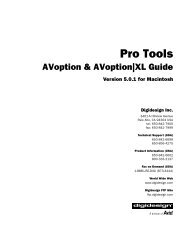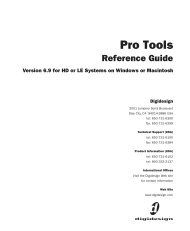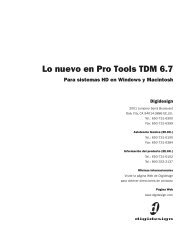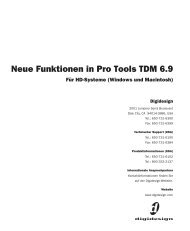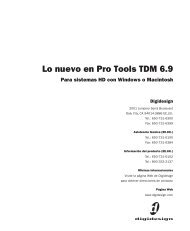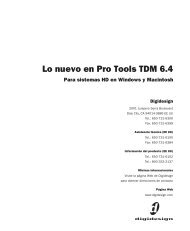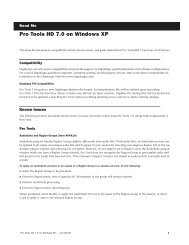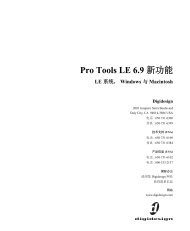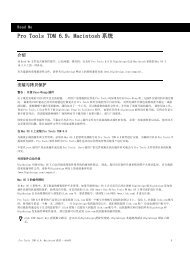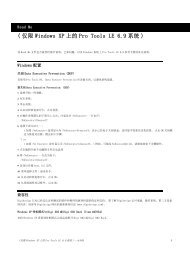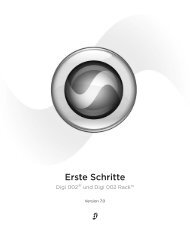5.1 DigiRack Plug-Ins Guide - Digidesign Support Archives
5.1 DigiRack Plug-Ins Guide - Digidesign Support Archives
5.1 DigiRack Plug-Ins Guide - Digidesign Support Archives
You also want an ePaper? Increase the reach of your titles
YUMPU automatically turns print PDFs into web optimized ePapers that Google loves.
34<br />
Using a Key Input for Side Chain<br />
Processing<br />
You can use the side-chain processing capabilities<br />
of the Compressor, Limiter, Gate, or Expander/Gate<br />
to trigger any of these plug-ins<br />
from a separate reference track or external audio<br />
source.<br />
By using the External Key input, you can control<br />
the dynamics of one audio signal using the dynamics<br />
of another signal (the key input). A typical<br />
use for this feature is to use one instrument<br />
to trigger gating of another: a kick drum to gate<br />
and tighten up a bass track, a rhythm guitar to<br />
gate a keyboard pad, and many other creative<br />
applications.<br />
Side-chain inputs are monophonic only.<br />
To use a key input for side chain processing:<br />
1 Click the <strong>Ins</strong>ert pop-up on the desired track to<br />
select the desired plug-in.<br />
2 Click the Side Chain Input pop-up and select<br />
the input/bus that carries the audio you want to<br />
use to trigger the plug-in.<br />
3 Click the Key Input button. This activates side<br />
chain processing.<br />
4 If you want to hear the audio source you have<br />
selected to control side chain input, click the<br />
Key Listen button.<br />
5 If you want to filter the Key Input so that only<br />
certain frequencies trigger the plug-in, use the<br />
Key HPF and Key LPF controls to select the desired<br />
frequency range.<br />
6 Begin playback. The plug-in is now using the<br />
input/bus that you chose as a side chain input to<br />
trigger its effect.<br />
<strong>DigiRack</strong> <strong>Plug</strong>-<strong>Ins</strong> <strong>Guide</strong><br />
7 Adjust the plug-in’s Threshold parameter to<br />
fine tune the side chain triggering.<br />
8 Adjust other parameters of the plug-in to<br />
achieve final effect that you want.<br />
Mod Delay<br />
The Mod Delay plug-in provides time delaybased<br />
effects. Effects obtained through the use<br />
of Mod Delay include slap echo, doubling, chorusing,<br />
and flanging.<br />
Mod Delay plug-in<br />
There are four different Mod Delays, each of<br />
which is capable of a different maximum delay<br />
time:<br />
• The Short Delay provides 1024 samples of delay<br />
(23.2 milliseconds at 44.1 kHz or 21.3 ms<br />
at 48 kHz).<br />
• The Slap Delay provides 7186 samples of delay<br />
(162 ms at 44.1 kHz or 149 ms at 48 kHz).<br />
• The Medium Delay provides 16384 samples of<br />
delay (371 ms at 44.1 kHz kHz or 341 ms at<br />
48 kHz).



